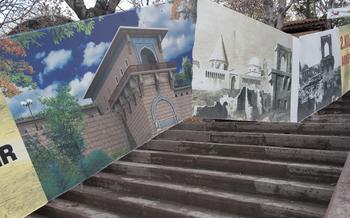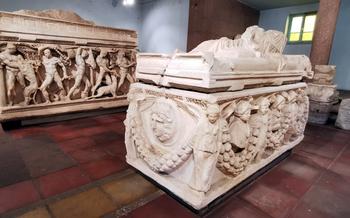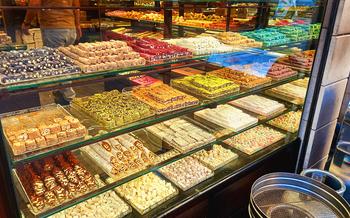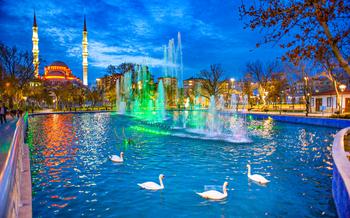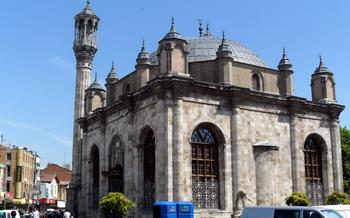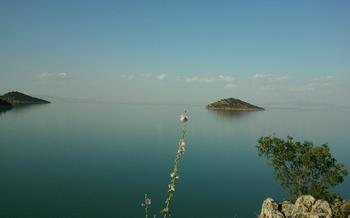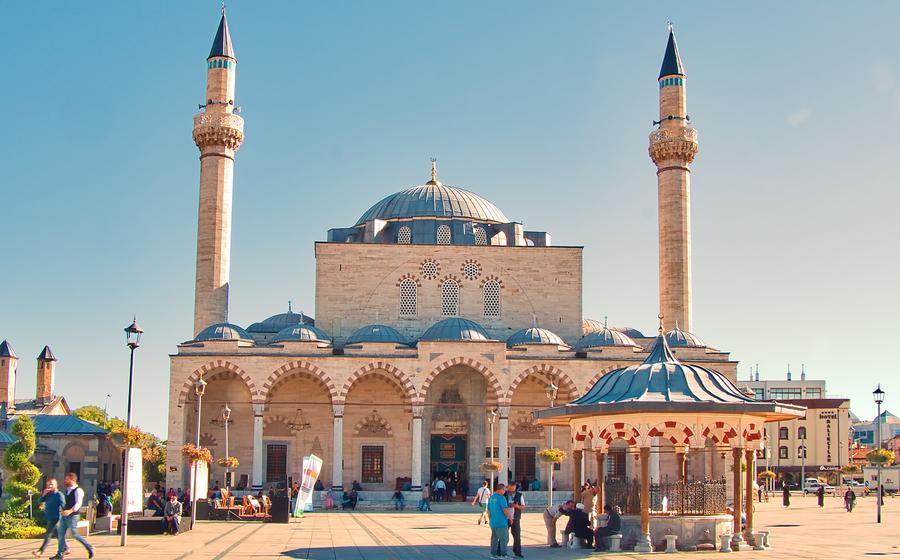
Seydisehir Eflatun Pinar Hittite Spring Sanctuary
- A journey back in time to the Hittite civilization
- Exploring the sacred Hittite spring
- Uncovering the secrets of the rock reliefs
- Stepping into the sacred chamber
- Discovering the Hidden Underground Tunnels
- Witnessing the Hittite New Year Festival
- Immerge yourself in the local culture
- Visit the Konya Archaeological Museum
- Admire the Beauty of Lake Beyşehir
- Experience the Mevlana Museum:
- Discover the Alaeddin Mosque:
- Indulge in Turkish Delights
- Venture into the Taurus Mountains:
- Insider Tip
A journey back in time to the Hittite civilization
The Hittites were an ancient Anatolian people who established a powerful empire in the second millennium BC. Their civilization flourished in what is now central Turkey, and their influence extended across the Middle East and the Mediterranean. The Hittites were skilled warriors, administrators, and traders, and they left behind a rich legacy of art, architecture, and literature.
One of the most important Hittite sites in Turkey is the Seydisehir Eflatun Pinar Hittite Spring Sanctuary. Located in the town of Seydisehir, Konya Province, the sanctuary is believed to have been a major religious and cultural center for the Hittites. The sanctuary was discovered in the 19th century by a German archaeologist, and excavations have been ongoing ever since. The site has yielded a wealth of artifacts, including rock reliefs, inscriptions, and pottery, which have shed light on Hittite religious beliefs and practices.
The Hittite Spring Sanctuary is a testament to the ingenuity and creativity of the Hittite civilization. It is a place where visitors can step back in time and experience the grandeur and majesty of one of the world's oldest civilizations.
Exploring the sacred Hittite spring
The Hittites held water in high esteem, viewing it as a divine gift and a source of life. They believed that certain springs possessed sacred qualities and were portals to the realm of the gods. The Eflatun Pinar spring, with its unique characteristics, was one such sacred site.
The Hittites believed that the spring's water had healing properties and that drinking or bathing in it could cure various ailments. They also believed that the spring was a place of communication with the gods. Rituals and ceremonies were performed at the spring to honor the gods and seek their blessings. These rituals often involved offerings of food, drink, and precious objects, which were deposited into the spring as a symbol of devotion.
The Hittites constructed a sanctuary around the spring to enhance its sacredness and provide a dedicated space for religious practices. The sanctuary included various structures, such as altars, temples, and bathing pools, which facilitated the performance of rituals and ceremonies. The Hittites also created intricate rock reliefs depicting gods, goddesses, and mythical figures around the spring, further emphasizing its religious significance.
Uncovering the secrets of the rock reliefs
The Seydisehir Eflatun Pinar Hittite Spring Sanctuary is home to an impressive collection of rock reliefs that offer a glimpse into the religious beliefs and artistic traditions of the Hittites. These reliefs, carved into the rocky cliffs surrounding the spring, depict a variety of gods, goddesses, and other mythical figures.
One of the most striking reliefs is that of the Hittite storm god, Teshub, who is depicted standing on a bull and holding a thunderbolt in his hand. Other reliefs depict the goddess Ishtar, the sun god Shamash, and the underworld god Nergal. These reliefs are not only visually impressive but also provide valuable insights into the Hittite pantheon and the religious practices of the Hittites.
The symbolic meaning of the reliefs is still debated by scholars, but it is believed that they served to protect the spring and its sacred waters. The Hittites believed that the spring was a gateway to the underworld, and the reliefs may have been intended to ward off evil spirits and ensure the purity of the water.
The reliefs were created using a variety of techniques, including carving, chiseling, and polishing. The Hittite artists demonstrated a remarkable skill in capturing the details of the human form and the intricate patterns of the clothing and jewelry worn by the gods and goddesses. The reliefs are a testament to the artistic achievements of the Hittite civilization and continue to fascinate visitors to the sanctuary to this day.
Stepping into the sacred chamber
Within the sanctuary, a sacred chamber holds great significance. Discovered during excavations, this chamber is believed to have been an important place for religious rituals and ceremonies. The architectural features of the chamber, including its size, shape, and orientation, suggest that it was carefully designed for specific purposes. Symbols and motifs found within the chamber provide clues to its meaning and use, offering insights into the beliefs and practices of the Hittites. Exploring this sacred space allows visitors to connect with the spiritual and cultural heritage of this ancient civilization.
Discovering the Hidden Underground Tunnels
Beneath the Seydisehir Eflatun Pinar Hittite Spring Sanctuary lies a hidden network of underground tunnels, adding an air of mystery and intrigue to this ancient site. Theories abound regarding their purpose, with some suggesting they served as secret escape routes or storage chambers for precious artifacts. Others believe they held religious significance, perhaps as a path to the underworld or a means of accessing sacred springs.
Exploring these tunnels presents a unique challenge, as they are often narrow, dark, and may require crawling or navigating through tight spaces. Proper safety precautions are essential, including bringing adequate lighting, wearing protective gear, and ensuring proper ventilation.
The potential rewards of exploring these tunnels are immense. They may contain hidden chambers, artifacts, or inscriptions that shed new light on Hittite culture and beliefs. Each step into these subterranean passages is a journey into the unknown, offering a glimpse into the hidden world of the Hittites.
Witnessing the Hittite New Year Festival
The Hittite New Year Festival was a grand and significant event that marked the beginning of a new year and the renewal of life. Held in the spring, the festival was a time for celebration, feasting, and religious rituals. The Hittites believed that the New Year was a time of transition and transformation, and they celebrated it with great enthusiasm.
The festival began with the king and his entourage processing to the Hittite Spring Sanctuary in Seydisehir. There, they performed rituals to honor the gods and goddesses and to ask for their blessings for the coming year. The king would then lead the people in a procession back to the city, where the celebrations continued.
During the festival, there were various rituals and ceremonies performed. People would exchange gifts, sing songs, and dance. There were also competitions and games, such as chariot races and archery contests. The festival was a time for people to come together and celebrate their shared culture and heritage.
The Hittite New Year Festival was a vibrant and joyous occasion that showcased the rich culture and religious traditions of the Hittites. It was a time for renewal, hope, and the celebration of life.
Immerge yourself in the local culture
Immerse yourself in the warmth and hospitality of the local people of Seydisehir, who are known for their friendly nature and eagerness to share their culture with visitors. Engage in lively conversations with the locals, learn about their daily lives, and gain insights into the rich traditions and customs that shape the community.
Explore the vibrant local markets and bazaars, where you can haggle for unique souvenirs, handcrafted goods, and fresh produce. Sample the tantalizing regional cuisine, which boasts a delectable array of flavors and aromas. Indulge in traditional Turkish dishes such as "etli ekmek" (meat-filled flatbread), "tantuni" (grilled meat wrap), and "mevlana şerbeti" (a sweet sherbet named after the famous poet Rumi).
Participate in traditional cultural activities and events that showcase the diverse heritage of the region. Attend mesmerizing performances of folk music and dance, witness the skill of local artisans creating intricate carpets and pottery, and join in the lively celebrations that bring the community together. Immerse yourself in the vibrant tapestry of Seydisehir's culture and create lasting memories that will transport you back to this enchanting land.
Visit the Konya Archaeological Museum
The Konya Archaeological Museum is a treasure trove of Hittite artifacts, offering visitors a deeper understanding of the rich history and culture of this ancient civilization. The museum houses an extensive collection of well-preserved artifacts, including sculptures, pottery, jewelry, weapons, and tablets inscribed with Hittite cuneiform.
One of the highlights of the museum is the collection of Hittite stone sculptures, which depict gods, goddesses, and mythical creatures. These sculptures provide valuable insights into the religious beliefs and artistic traditions of the Hittites. The museum also displays a remarkable collection of pottery, including both functional and decorative pieces. These artifacts showcase the skill and craftsmanship of Hittite potters and offer glimpses into everyday life during the Hittite period.
In addition to the stone sculptures and pottery, the Konya Archaeological Museum also houses a collection of Hittite jewelry, including necklaces, bracelets, earrings, and rings. These intricate pieces of jewelry demonstrate the artistry and attention to detail of Hittite artisans. The museum also displays a variety of Hittite weapons, including swords, daggers, and arrowheads, which provide insights into the military prowess of this ancient civilization.
For those interested in learning more about the Hittite language and writing system, the Konya Archaeological Museum houses a collection of tablets inscribed with Hittite cuneiform. These tablets contain a wealth of information about Hittite history, religion, and culture. The museum offers guided tours and educational programs that provide visitors with the opportunity to learn more about the Hittites and their fascinating civilization.
Admire the Beauty of Lake Beyşehir
Lake Beyşehir, located just a short drive from Konya, is a breathtaking natural wonder that offers a serene escape and a chance to embrace the beauty of the region. Surrounded by lush green hills and dotted with small islands, the lake's crystal-clear waters create a stunning backdrop for a relaxing getaway.
Diverse Flora and Fauna: Lake Beyşehir is a haven for nature enthusiasts, boasting a rich diversity of flora and fauna. The surrounding hills are home to a variety of wildflowers, including vibrant poppies, delicate daisies, and fragrant lavender. The lake itself supports a diverse range of aquatic life, including fish, turtles, and waterfowl. Birdwatching enthusiasts can spot a variety of migratory birds, including herons, egrets, and cormorants, which find refuge in the lake's tranquil waters.
Outdoor Activities: Lake Beyşehir offers a range of outdoor activities for adventure seekers and nature lovers. Visitors can embark on a leisurely boat trip to explore the lake's hidden coves and islands, or indulge in a spot of fishing in the lake's pristine waters. Hiking enthusiasts can follow scenic trails that wind through the surrounding hills, offering breathtaking views of the lake and the surrounding countryside.
Historical and Cultural Significance: Beyond its natural beauty, Lake Beyşehir holds historical and cultural significance. The lake has been an important source of livelihood for local communities for centuries, with fishing and agriculture playing a vital role in the region's economy. The lake is also home to several historical sites, including ancient ruins and medieval castles, which provide a glimpse into the area's rich past.
Experience the Mevlana Museum:
Journey into the heart of Konya and immerse yourself in the profound teachings of the revered Sufi mystic, Mevlana Rumi, at the Mevlana Museum. This iconic landmark, nestled within the tranquil Mevlana Cultural Park, is a testament to Rumi's enduring legacy and the transformative power of his philosophy.
Step through the museum's grand entrance and be greeted by an awe-inspiring sight: the exquisite tomb of Mevlana Rumi, adorned with intricate tilework and calligraphy that pay homage to his spiritual greatness. Delve deeper into Rumi's life and teachings as you explore the museum's captivating exhibits, which showcase his manuscripts, personal belongings, and symbolic objects that illuminate his mystical journey.
Discover the essence of Mevlana's teachings, emphasizing love, compassion, and unity, which have resonated with seekers of truth for centuries. Immerse yourself in the serene atmosphere of the museum, where you can pause and reflect on the profound messages embedded in Rumi's poetry and teachings.
As a highlight of your visit, witness the mesmerizing Mevlana Whirling Dervishes Ceremony, a captivating spiritual performance that embodies the principles of Rumi's philosophy. Observe as the dervishes gracefully rotate in perfect harmony, symbolizing their connection to the divine and their surrender to the cosmic dance of existence.
Whether you're a spiritual seeker, a history buff, or simply someone in search of profound wisdom, the Mevlana Museum offers an unforgettable experience that will leave an enduring mark on your soul.
Discover the Alaeddin Mosque:
In the heart of Konya, the Alaeddin Mosque stands as a testament to the city's rich history and architectural splendor. Built in the 13th century during the Seljuk era, this magnificent mosque is a masterpiece of Islamic architecture and a symbol of Konya's religious and cultural heritage.
Adorned with intricate tilework, calligraphy, and stunning Seljuk craftsmanship, the Alaeddin Mosque captivates visitors with its beauty and grandeur. The mosque's towering minarets pierce the sky, while its vast courtyard offers a serene space for prayer and contemplation.
Inside, the mosque's interior is equally impressive. The walls are adorned with verses from the Quran, while the ceiling is adorned with intricate patterns and designs. The central dome, supported by massive pillars, creates a sense of awe and inspiration.
The Alaeddin Mosque is not only a place of worship but also a center of religious and cultural life in Konya. It serves as a venue for Islamic teachings, cultural events, and community gatherings. During prayer times, the mosque comes alive with the voices of worshippers, creating a vibrant and spiritual atmosphere.
Visitors to Konya should not miss the opportunity to explore the Alaeddin Mosque and immerse themselves in its rich history and architectural beauty. This iconic landmark offers a glimpse into the city's past and remains an important symbol of Konya's Islamic heritage.
Indulge in Turkish Delights
When in Konya, one cannot miss the opportunity to savor the delectable Turkish delights, an iconic sweet treat that has captured the hearts of people worldwide. These bite-sized pieces of heaven come in a variety of vibrant colors and flavors, offering a delightful explosion of taste in every bite.
Turkish delights are made from a blend of sugar, cornstarch, and water, cooked until it reaches a thick, gooey consistency. This mixture is then flavored with various essences, such as rosewater, orange blossom water, or pistachio, and cut into small cubes. The cubes are then coated in powdered sugar, which gives them their signature matte finish and prevents them from sticking together.
The flavors of Turkish delight are as diverse as they are delicious. From the classic rose and pistachio varieties to more exotic options like pomegranate, lemon, and even lavender, there is a flavor to suit every palate. The texture is soft and chewy, with a slight crunch from the powdered sugar coating.
In Konya, Turkish delights are a beloved treat, often served with Turkish coffee or tea. They can be found in traditional sweet shops, known as "lokumcular," as well as in markets and bazaars. Whether you choose to indulge in a single piece or a whole box, Turkish delights are a must-try culinary experience in Konya.
Insider Tip:
- For the ultimate Turkish delight experience, visit the Haci Bekir lokumcular, a renowned sweet shop in Konya that has been crafting these delectable treats since 177
- If you're looking for a unique souvenir to take home, consider purchasing a box of Turkish delights adorned with intricate designs or calligraphy.
- Turkish delights are also a popular ingredient in other desserts, such as baklava and ice cream. Be sure to try these delicious creations to fully immerse yourself in the Turkish culinary journey.
Venture into the Taurus Mountains:
Beyond the bustling streets of Konya lies the majestic Taurus Mountains, beckoning adventurers and nature enthusiasts alike. As you leave the city behind, the terrain transforms into a breathtaking tapestry of towering peaks, verdant valleys, and pristine forests. Embrace the call of the wild and embark on an unforgettable journey into this natural paradise.
The Taurus Mountains, stretching across southern Turkey, offer a sanctuary for a diverse array of flora and fauna. Keep your eyes peeled for soaring eagles, nimble ibex, and the occasional glimpse of elusive leopards. The region's rich biodiversity is a testament to the unspoiled wilderness that awaits exploration.
Lace up your hiking boots and set off on one of the many trails that crisscross the mountains. From gentle paths suitable for leisurely strolls to challenging ascents that reward with panoramic views, there's a trail for every level of hiker. As you traverse the rugged terrain, let the tranquility of nature wash away the stresses of daily life.
For those seeking a more immersive experience, camping under the stars is a must. Pitch your tent in designated campsites and let the symphony of nature lull you to sleep. As darkness descends, marvel at the unpolluted night sky ablaze with countless stars, a celestial spectacle that will leave you in awe.
For the more adventurous, the Taurus Mountains offer ample opportunities for mountain climbing. Scale sheer rock faces, navigate treacherous gorges, and conquer towering peaks. Feel the adrenaline rush as you ascend, and revel in the sense of accomplishment as you reach the summit, where breathtaking views await.
As you explore the Taurus Mountains, be sure to interact with the local nomadic communities who call this region their home. Learn about their traditional way of life, rooted in harmony with nature, and gain insights into their unique culture. Their hospitality and knowledge of the mountains will enrich your journey in countless ways.
So, pack your bags, embrace your adventurous spirit, and venture into the Taurus Mountains. Let the pristine landscapes, diverse wildlife, and rich cultural heritage captivate and inspire you. From tranquil hikes to thrilling climbs, this natural playground offers an unforgettable experience for every traveler seeking an escape into the wild.
Insider Tip
Best time to visit: To fully appreciate the beauty and significance of the Seydisehir Eflatun Pinar Hittite Spring Sanctuary, plan your visit during the spring or autumn months (April-May or September-October). The weather is pleasant, and the surrounding landscape is at its most vibrant.
Safety in the underground tunnels: While exploring the underground tunnels, safety should be your top priority. Bring a flashlight or headlamp to navigate the dark passages. Wear appropriate clothing and sturdy shoes, as the tunnels can be damp and slippery. Avoid exploring alone, and inform someone about your plans before entering the tunnels.
Respect local customs: Konya is a conservative city, so it's important to be respectful of local customs and traditions. Dress modestly, covering your shoulders and knees. Be mindful of your behavior in public, and avoid public displays of affection.
Hidden gems and lesser-known attractions: Beyond the main attractions, Konya offers several hidden gems waiting to be discovered. Explore the historic district of Alaeddin Hill, with its narrow streets and traditional Ottoman houses. Visit the Karatay Madrasah, a 13th-century Islamic school with stunning tilework and architecture. Don't miss the Sille Whirling Dervishes Performance, a captivating display of traditional Sufi dance.

